Pauli exclusion principle - Study guides, Class notes & Summaries
Looking for the best study guides, study notes and summaries about Pauli exclusion principle? On this page you'll find 132 study documents about Pauli exclusion principle.
Page 4 out of 132 results
Sort by

-
CHM 115 Exam 2 Purdue Latest Update Graded A+
- Exam (elaborations) • 5 pages • 2024
- Available in package deal
-
- $8.99
- + learn more
CHM 115 Exam 2 Purdue Latest Update Graded A+ Degeneracy Orbitals with a given n having identical energy Metals Lose electrons from valence shall form cations internal energy Potential and kinetic energy of all particles that make up the system nonmetals Add electrons to valence shells, form negative ions (anions) Work Energy transferred when an object moves by a force enthalpy total heat content of a system First law of thermodynamics ΔEsys = q + w What happens to enthalpy under constan...

-
Chem 219: Exam Questions With 100% Correct Answers
- Exam (elaborations) • 19 pages • 2024
- Available in package deal
-
- $12.49
- + learn more
Chem 219: Exam Questions With 100% Correct Answers The speed of a wave (c) is the product of its frequency (ν) and wavelength (λ). E = hv = h x c / λ nm to m or m to nm 1 m / 10^9 nm or 10^9 nm / 1 m What is the maximum number of electrons that can have the quantum numbers n = 3, ℓ = 2, mℓ = -2? The Pauli exclusion principle states that no two electrons in a given atom can share the same set of four quantum numbers (n, ℓ, mℓ, ms). This set of quantum numbers contains thr...

-
1030 Final exam 20242025 with 100 correct answers
- Exam (elaborations) • 14 pages • 2024
-
- $14.49
- + learn more
1030 Final exam 2024/2025 with 100% correct answers Filtration Distillation Chromatography (paper) Intensive Properties Extensive Properties Atomic Number and Mass Number Isotopes Mole Avogadro's Number (NA) Electrostatic energy Quantized energy (Max Planck) Heisenberg's Uncertainty Principle Principal Quantum Number (n) Angular Momentum Quantum Number (l) Magnetic Quantum Number (ml) Electron Spin Quantum Number (ms) Degenerate orbitals Aufbau principle Pauli Exclusion Prin...

-
1030 Final exam 20242025 with 100 correct answers
- Exam (elaborations) • 14 pages • 2024
-
- $12.49
- + learn more
1030 Final exam 2024/2025 with 100% correct answers Filtration Distillation Chromatography (paper) Intensive Properties Extensive Properties Atomic Number and Mass Number Isotopes Mole Avogadro's Number (NA) Electrostatic energy Quantized energy (Max Planck) Heisenberg's Uncertainty Principle Principal Quantum Number (n) Angular Momentum Quantum Number (l) Magnetic Quantum Number (ml) Electron Spin Quantum Number (ms) Degenerate orbitals Aufbau principle Pauli Exclusion Prin...

-
TEST BANK FOR ORGANIC CHEMISTRY WITH BIOLOGICAL TOPICS 6th EDITION ISBN : 9781260325294 ALL CHAPTERS INCLUDED.
- Exam (elaborations) • 957 pages • 2023
-
- $17.99
- + learn more
TEST BANK FOR ORGANIC CHEMISTRY WITH BIOLOGICAL TOPICS 6th EDITION ISBN : 9781260325294 ALL CHAPTERS INCLUDED. Chapter 1 1 MULTIPLE CHOICE QUESTIONS Topic: Atomic Orbitals 1. In quantum mechanics a node (nodal surface or plane) is: A) a place where Ψ is negative. B) a place where Ψ is positive. C) a place where Ψ = 0. D) a place where Ψ 2 is large. E) a place where Ψ 2 is negative. Ans: C Topic: Atomic Orbitals, Molecular Orbitals 2. When the 1s orbitals of two hydroge...
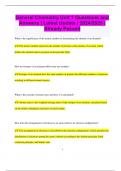
-
General Chemistry Unit 1 Questions and Answers | Latest Update | 2024/2025 | Already Passed
- Exam (elaborations) • 9 pages • 2024
- Available in package deal
-
- $10.22
- + learn more
General Chemistry Unit 1 Questions and Answers | Latest Update | 2024/2025 | Already Passed What is the significance of the atomic number in determining the identity of an element? The atomic number represents the number of protons in the nucleus of an atom, which defines the element and its position on the periodic table. How do isotopes of an element differ from one another? Isotopes of an element have the same number of protons but different numbers of neutrons, resulting in d...
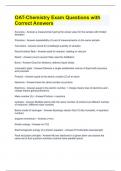
-
OAT-Chemistry Exam Questions with Correct Answers
- Exam (elaborations) • 11 pages • 2024
-
Available in package deal
-
- $14.49
- + learn more
Accuracy - Answer-a measurement giving the actual value for the sample with limited deviation Precision - Answer-repeatability of a set of measurements on the same sample Test tubes - Answer-Good for small/large quantity of samples Round bottom flask - Answer-used for reaction, heating or vacuum Retort - Answer-round vacuum flask used for distillation Buret - Answer-Good for titrations, delivers liquid slowly Volumetric pipet - Answer-Delivers a single established volume of liq...
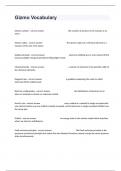
-
Gizmo Vocabulary Complete Assignment With 100% Verified Answers.
- Exam (elaborations) • 2 pages • 2024
-
Available in package deal
-
- $11.99
- + learn more
Atomic number - correct answer the number of protons in the nucleus of an atom. Atomic radius - correct answer The atomic radius of a chemical element is a measure of the size of its atoms Aufbau principal - correct answer electrons orbiting one or more atoms fill the lowest available energy levels before filling higher levels Chemical family - cor...
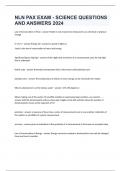
-
NLN PAX EXAM - SCIENCE QUESTIONS AND ANSWERS 2024
- Exam (elaborations) • 11 pages • 2024
-
- $13.49
- + learn more
Law of Conservation of Mass Matter is not created nor destroyed in any chemical or physical change E= mc^2 Energy (e)= mass(m) x speed of light (c) -basis is the law of conservation of mass and energy significant figures (sig figs) all the digits that are known in a measurement, plus the last digit that is estimated Kelvin scale theoretical temperature that is the lowest called absolute zero absolute zero The temperature at which no more energy can be removed fr...
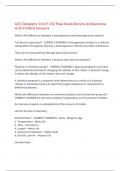
-
ACS Chemistry 101 & 102 Final Exam Review 44 Questions with Verified Answers,100% CORRECT
- Exam (elaborations) • 7 pages • 2024
-
- $10.99
- + learn more
ACS Chemistry 101 & 102 Final Exam Review 44 Questions with Verified Answers What is the difference between a homogeneous and heterogeneous mixture? Can they be separated? - CORRECT ANSWER A homogeneous mixture is a uniform composition throughout whereas a heterogeneous mixture has other substances. They can be separated but through physical processes. What is the difference between a physical and chemical property? Physical vs chemical change? - CORRECT ANSWER A physical prope...

How did he do that? By selling his study resources on Stuvia. Try it yourself! Discover all about earning on Stuvia


